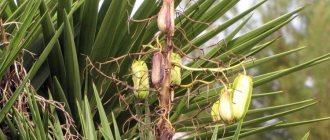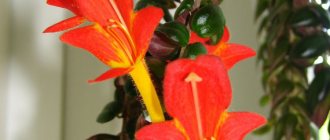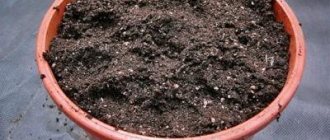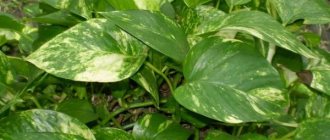The beautiful Bacopa plant evokes associations with a bouquet of wildflowers. It is unusual, surprising, inspiring. It was brought from Europe relatively recently, so there is no better option for creating an original design.
If there is no space on the windowsill, you can choose a hanging stand and enjoy the splendor, lush flowering, and delicate aroma. The flower can be planted in the yard, flower bed or garden.
Its beauty is difficult to ignore; friends, relatives, guests, and neighbors will definitely pay attention to it. A friendly meeting will be remembered for a long time and will leave a lot of positive impressions.
Description
Bacopa (sutera) cordata
Bacopa (sutera) is an aquatic or semi-aquatic plant that is successfully grown in open flower beds, in flowerpots, on window sills, in ponds and aquariums. The birthplace of this unusual flower is South Africa; some varieties are found in the Canary Islands. In some countries the plant is called bakote or bakola.
Ampel varieties can reach 70 cm in height, aquarium varieties grow up to 40–45 cm, succulent varieties from 30 to 50 cm.
The crown of bacopa is branched, so to make it more decorative it is necessary to carry out formative pruning. But as you can see in numerous photos, the natural growth of branches looks very original.
Aquarium bacopa
The petals are soft or rich green in color, round in shape, depending on the variety, dense, fleshy or thin and lacy. They grow in pairs or are located on a branch of 5-10 pieces. The stems of ampelous species are dense and flexible, while the stems of aquatic species are delicate, but quite strong.
The ampelous bacopa flower is well suited for landscaping garden recreation areas, verandas, loggias, open balconies and entrance areas. Bush and herbaceous varieties look great when planted in groups in flower beds, and aquatic varieties ideally complement aquarium decorations, allowing you to create a unique underwater corner in your apartment.
Abundant and friendly flowering of bacopa
Small buds bloom almost simultaneously. The duration of the first wave is short, but new buds appear to replace faded buds, so the bush blooms almost continuously.
The buds open only during daylight hours and close at night.
The flowers are formed from five rounded petals. The surface can be smooth or terry.
Terry bacopa
The most common is Bacopa Raphael, whose flowers are white. Less commonly, you can find the blue bacopa variety or varieties with pink or pale purple petals.
Typically, gardeners choose the bacopa snowtopia variety for planting on balconies and verandas. This species is quite unpretentious, about 63 cm in height. Blooming snowtopia looks like a snowball of snow-white flowers.
Another popular annual variety of bacopa is bluetopia. The variety is distinguished by its light-loving nature and lush flowering.
It is worth considering that the absence of sun causes the plant to stretch out, so it will not have the strength to form buds.
The flowers are blue, light blue or purple, the leaves are pale green. The height of an adult bush is up to 58 cm.
Appearance
The Blue variety is a perennial flower with thin shoots that spread and creep, leaning down. The stem can grow up to 0.7 meters in length. The plant grows well in breadth; its leaves are small in size and have an oval shape. The fast-growing foliage with double blue flowers grows rapidly to form a lush bush. During the first flowering it produces a lot of fruits and is covered with beautiful flowers, then the flowers gradually fall off on their own, while it has a good appearance. After a short rest it produces beautiful flowers again.
Bacopa Blue can be used on balconies and building facades. It looks beautiful with other flower crops, and at the peak of flowering it looks like a large lush ball of flowers. To do this, it is necessary to pinch the shoots, cutting them off when they reach a length of up to 0.6 m.
Types and varieties of bacopa
Breeders have developed more than 55 hybrid varieties for growing at home. Among others, gardeners distinguish the hybrid species Bacopa bluetopia with white buds and Bacopa Vasilisa with a delicate lilac color. According to reviews, the most common variety is considered to be ampelous bacopa, but succulent species are more often grown in the house on window sills, and aquatic varieties of bacopa (sutera) are grown in aquariums. This article provides a description of the most popular varietal varieties with photos.
Australian bacopa bacopa australis
Aquarium bacopa.
Photo This is an aquarium variety that is used to create underwater compositions and decorate ponds and artificial reservoirs.
Australian bacopa is a fast-growing species that can grow from a small sprout to a lush thicket in a short time.
The plant has a powerful root system and bright green leaves. The shape of the leaf blades is ovoid, length from 1.5 cm, width from 1.1 cm. The flowering period is quite long and often falls in the summer. Small blue flowers bloom above the surface of the water.
Bacopa caroliniana bacopa caroliniana
One of the most popular aquarium varieties. In its natural environment it is found in flooded fields and shallow reservoirs. Height is from 16 to 52 cm. The plant is unpretentious and grows well in a shaded pond or a regular aquarium.
The stems are rigid and poorly branched, the shoots are vertical. The leaves are dense, from 1 to 2.3 cm in length, oval-oblong in shape.
The color of the foliage in the sun becomes reddish, and in the shade it remains green.
The buds are not large, deep blue in color.
The bacopa plant tolerates transplantation, temperature changes and poor lighting well. The variety is often used to decorate ponds, fountains, alpine slides and other decorative objects in private gardens or public parks.
Bacopa monnieri bacopa monnieri
This is an unusual succulent species that is quite easy to grow in an aquarium or in a deep planter. The main thing is that the root system of the plant is in water and does not dry out. In its natural environment, Bacopa monnieri is considered a weed; it often grows in rice fields and causes a lot of trouble for farmers.
At home, the height of an adult bush is from 30 to 48 cm. The shoots are creeping and strong. The leaf blades are without stems and grow directly on the branch. The shape of the leaves is round or oval, slightly elongated towards the edge. The edge of the plates can be smooth or jagged. The flowers are pale blue, reddish or snow-white.
Bacopa diffuses
This perennial bacopa is often called “beautiful” and is used to decorate balconies, verandas and gazebos. The length of the hanging shoots is 53-65 cm, the crown is lush with dense green foliage.
The plant withstands rainy and dry weather.
The flowering is bright and lush. The diameter of the opened buds is up to 3 mm, the color is white, pinkish or blue.
Bacopa cordata
This is a perennial crop of herbaceous type. It is easily propagated by seeds and is unpretentious. The height of an adult plant is from 11 to 22 cm. Bacopa heart-shaped blooms with snow-white, light purple or pink buds. The foliage is rich green, the crown is dome-shaped.
Bacopa for aquarium. Video
Propagation by cuttings and layering
An easier way to propagate bacopa is by rooting cuttings and layering. The cutting quickly grows a powerful root system, and the grown bush begins to bloom 2-2.5 months after planting. For cuttings, cut off the tops of plants 10 cm long with two leaves.
They are rooted either in water or in loose, moist soil, which consists of equal parts of sand and vermiculite. The top is buried in the soil so that one node is underground, from which the root system develops. The second should be above the surface from which shoots will grow.
The roots grow within 2-3 weeks. To speed up the process, cuttings are treated with phytohormones or growth stimulants. To create greenhouse conditions, the seedlings are covered with a cap or film and placed in a bright place, protected from direct sunlight.
The soil is kept moist at all times. The film is periodically removed to ventilate and moisten the soil. When shoots appear, the cap is removed. When the second pair of leaves forms, the top is pinched to stimulate tillering. It is better to carry out cuttings from January to April, as well as in the summer after pruning, when a large amount of planting material remains.
When propagating by layering, the following steps are carried out:
- A container with fertile soil is placed next to the pot of the mother plant.
- The branches of the sutera are laid out on the soil and secured well using a metal bracket or other device. The shoots receive nutrition from the mother bush, so the root system grows quickly.
- Periodically dig up the ground under the rooting site and check how the roots grow. If they are sufficiently developed, then the stems are cut off from the mother plant and a new flower is obtained.
Features of growing at home
Growing bacopa is a fairly simple and interesting process. But it should be borne in mind that the culture loves water and sunlight, so it is necessary to follow the watering schedule and place the flowerpots on well-lit windowsills.
For proper growth and development, the sutera should be in the sun for about 10–12 hours a day. In winter, it is necessary to illuminate the flower with special lamps.
Do not place a flower pot near heating systems or other heating devices.
You need to choose a place where there are no drafts or other irritating factors.
Bacopa grown at home from seeds is transplanted into open ground in the summer, and brought indoors in winter. The temperature in winter should not be higher than +8 +15 °C. During this period, bacopa is at rest, gaining strength for spring growth.
It is best to start growing bacopa from seeds, a photo of which is in the article, in early spring. It is during this period that you can grow a strong and healthy flower, which by autumn will be able to please its owner with abundant flowering.
Hanging pots or flowerpots are suitable for planting plants with hanging shoots.
The pot must have drainage holes, since some varieties, although they are moisture-loving, do not tolerate stagnation of water at the roots.
Growing bacopa from seeds
How to sow seeds
For the primary cultivation of bacopa, you will have to resort to the seed propagation method. Growing bacopa from seeds does not involve any particular difficulties, and purchasing high-quality seed material in the store is not a problem. When to sow bacopa for seedlings? Sowing is carried out in March in a peat substrate sterilized for 4 hours in the oven at a temperature of 100 ºC, which, after cooling, is placed in a container with transparent walls. There is no need to bury the bacopa seeds; just press them to the surface of a moistened substrate and cover them with film or glass. Bacopa germinates from seeds in the light, at a temperature not lower than 20 ºC. Shoots can appear in 10-14 days, and the full germination period can last 3-4 weeks.
Seedling care
Caring for bacopa during the seedling period is simple. Once seedlings begin to emerge, it is important not to allow the substrate to dry out. Remember to carefully loosen the soil around the seedlings. At the stage of development of seedlings with three true leaves, the first picking of bacopa is carried out - transplanting the seedlings into separate peat pots with a diameter of 5 cm. After the seedlings have settled in the new place, they are fed with complex mineral fertilizer in half the dose recommended by the manufacturers. The optimal temperature for growing bacopa seedlings is 22-26 ºC.
- Photo of Persian cyclamen
If you are going to plant seedlings in the garden, then most likely the bacopa seedlings will require a second picking - transplanting into larger pots, which, for the stability of the seedlings, is carried out with the stem buried by one node. A week after the second picking, when the bacopa seedlings have taken root, they are fed with complete mineral fertilizer with a predominance of phosphorus and nitrogen, after which the temperature in the room during the day is maintained within 15-24 ºC, and at night – about 13-15 ºC.
If you grow bacopa as a houseplant, then there is no need to carry out a second picking - the seedlings are immediately transplanted into a pot or basket.
How to plant in open ground
In order for bacopa to grow and develop better in the garden, you need to choose a well-lit area where there is no piercing wind, drafts and stagnant humidity.
It is important to remember that poor lighting will lead to elongation of shoots, and flowering will be faded and short-lived.
Sutera is not demanding on soil composition and grows well in almost any area. The main condition is that the soil has good air and moisture permeability and is also saturated with nutrients. To do this, gardeners recommend adding humus, compost and other rotted organic matter to the soil.
Before planting seedlings in a permanent place, gardeners recommend hardening off the sprouts. This will help them get stronger and in the future easily tolerate temperature changes, rainy days and wind. Seedlings are planted in open ground only after the threat of return frosts has passed.
Bacopa – photo
And to more clearly demonstrate how diverse and impressive bacopa can be, we have collected a large selection of photographs!
Photo: asienda.ru
Photo: totalhub.ru
Photo: rastenievod.com
Photo: flo.discus-club.ru
Photo: onava.lv
Photo: clasbio.ru
Photo: botanichka.ru
Photo: sobolevsad.ru
Photo: pinterest.ru
Photo: biosalus.net
Photo: tripchik.ru
Photo: lanshaft.com
Photo: waysi.ru
Photo: aqvadom55.ru
Photo: cveti-rasteniya.ru
Photo: flo.discus-club.ru
Photo: chistiy-dom35.ru
Photo: akvariumnyerybki.ru
Photo: riversidegardencentre.com
Photo: akvabluz.ru
Photo: 2110658.ru
Photo: sissinghurstcastle.wordpress.com
Photo: dendauwfilip.be
Did you like the post? Subscribe to our channel in Yandex.Zen, it really helps us in our development!
How to properly care
Sutera is not a demanding plant, so even a beginner can cope with its cultivation. Bacopa care includes regular watering, fertilizing, weeding, loosening the soil, and preparing for the winter. By following simple care and growing conditions, you can achieve abundant flowering already in the first year after sowing an exotic crop.
Watering
Bacopa needs to be watered regularly and abundantly. But the plant does not tolerate stagnant moisture, so flowerpots and pots must have drainage holes.
When planting at the bottom of a hole or flowerpot, it is necessary to add a drainage layer of broken brick or expanded clay.
Top dressing
Bacopa, like other plants, can be fed only in spring and summer. With the onset of cold weather, all feeding is stopped, and the flower is prepared for the winter period. For feeding, organic fertilizers are usually used, such as mullein solution, compost, diluted bird droppings or vermicompost.
During the growth period, it is advisable to apply nitrogen-containing fertilizers. And during flowering, the plant is fed with mineral complex compounds that contain potassium, phosphorus, iron and magnesium.
Wintering
Bacopa flowers tolerate short frosts well, so in warm climate zones it will be enough to build a shelter from hay, burlap or spruce branches. But in cold regions, perennials are best dug up and moved indoors.
Preparing for the winter period:
- To do this, the bushes are pruned, removed from the flowerbed along with a lump of earth and transplanted into a flowerpot.
- The storage temperature should not be lower than +10 and higher than +15 °C.
- The room should be shaded.
- Check the soil and, if necessary, moisten it a little so that the roots do not dry out.
- Closer to spring, the flower is transferred to a warm room and watered.
- After the plant forms its first shoots, cuttings are taken from them for propagation.
The mother bush is planted in a flowerbed when the earth has warmed up and the threat of spring frosts has passed.
Step-by-step instructions for sowing bacopa for seedlings
You can correctly plant bacopa seeds for seedlings according to the following scheme:
- Place a drainage layer (about 1.5-2 cm) on the bottom of the selected container. For example, broken brick, perlite, small expanded clay.
- Fill the container with soil mixture, but not to the very brim, leave a small gap.
- Moisten the soil surface generously with a sprayer. The water in it should be warm and clean.
- Sow bacopa seeds. Granulated seeds should be planted at a distance of 2.5-3 cm from each other.
- The granules are lightly pressed into the soil surface. The planting is superficial, that is, there is no need to cover them with soil!
- Moisten the soil again with a spray bottle, and then cover with some kind of shelter, for example, a lid, cling film, glass.
If you have ordinary sutera planting material (that is, simple seeds, not granulated), then planting is carried out according to a slightly different scheme.
Since the seeds are fine as dust, it is better to mix them with a small amount of sand. Sowing is done in furrows (the distance between them is 3-4 cm, depth - 3-5 mm). Seeds should be sown evenly in the furrows, as if salting the surface. After sowing, you need to lightly press the seeds with your finger into the surface of the furrow. Afterwards, moisten the soil surface again with a spray bottle. Do not cover the grooves with earth or sand, just cover them with film or a lid.
Reproduction methods
For propagation at home, two methods are used: growing bacopa from seeds and propagating bacopa from cuttings. Despite the exotic past of the culture, the propagation of bacopa is not a complicated and quite exciting process.
It is quite easy to propagate and grow sutera from seeds. The seed can be collected independently or purchased in a store.
Sowing is carried out in early spring, around February or March. For planting seed, flat, wide containers and soil made from a mixture of flower soil, sand or vermiculite are suitable. The first sprouts appear in the second week after sowing. Picking of seedlings is carried out after the formation of 4 true leaves.
Bacopa cuttings are carried out in early spring from the mother bush, which overwintered indoors.
Bacopa cuttings
Rooting of cuttings is carried out in water with growth stimulants or in nutrient soil. Roots form already in the second week. You can plant the plant in open ground after new leaves begin to form on it.
It is important to remember that sutera is afraid of frost and plant only after the temperature has completely stabilized.
Rules of agricultural technology
To turn your yard or garden into a piece of paradise, you need to know the features of planting and caring for bacopa. The rules of agricultural technology are simple and easy to master for amateurs and beginners.
Place
The choice of location is a decisive factor for successful cultivation. It is important to choose a site with good lighting, because bright sun is necessary for vigorous bud formation throughout the summer. In the shaded area, rapid growth will be observed, the shoots will begin to grow very quickly, but the flowering will be sparse and short-lived. If the bush is planted as a ground cover for a shady place, then it will cope with its function perfectly. Good development is possible on a site without drafts and winds.
The soil
The plant is successfully grown in different types of soil, but for best results the following indicators are necessary:
- nutritious soil with a large amount of humic substances;
- permeability for good air exchange;
- weakly acidic reaction of the substrate.
If the soil is alkaline, it is recommended to add potassium sulfate to it before planting.
For growing in a hanging pot or ampel pot, you can buy soil for azaleas, hydrangeas or conifers, or you can prepare it yourself. For this you will need:
- old cow dung - 2 parts;
- turf soil - 1 part;
- coarse river sand – 1 part;
- black peat – 1 part.
The container must have drainage holes and a layer of expanded clay for normal drainage of water after watering.
Landing
Seedlings are planted in a permanent place in open ground when the threat of night frosts disappears. In the middle zone, this time begins in the last ten days of May, and in the southern regions - at the end of April.
When mass planting, it is necessary to maintain a distance between neighboring seedlings, otherwise they will compete with each other during cultivation, and stronger specimens will suppress the rest. For short people, the interval is 10 cm, and for tall people, 25 cm.
During transplantation, it is best to follow the transshipment technique, that is, try not to destroy the earth ball and move the plant so that the roots are not damaged. Damage to the root system is the most common cause of failure during planting.
Watering
Like all succulents, bacopa can tolerate dry periods for some time, but this has a bad effect on its decorative properties. If there has been no rain for a long time, and the weather is hot, you will need to water the plants, and then loosen the soil. In this case, you should be careful, since the root system of the sutera is located just under the surface, and it is easy to damage it with a hoe. Loosening will allow you to break up the dry crust and ensure air exchange in the soil. It is advisable to carry out weeding not with an ordinary garden hoe, but with a small tool for indoor flowers.
Plants in closed containers need active watering. In summer you will need to moisturize them daily, and in the hottest weeks - in the morning and evening. It is advisable to do this before the sun rises high and after sunset, so that burns do not appear at the site of the drops.
Feeding
2 weeks after transplantation, you can start fertilizing with complexes for decorative foliage crops at ½ dosage. This procedure is carried out once a week. As soon as the first buds appear, the product is changed to fertilizer for abundantly flowering ones, for example, for petunias and surfinias. During abundant flowering, feed once a week until autumn. If the flower is planned to be sent for the winter, the application of mineral complexes is stopped at the end of August.
Instead of synthetic products, weak solutions of mullein or chicken droppings are often used.
Trimming
To prevent bacopa shoots from becoming bare, periodic pruning is necessary. During this process, adult branches are shortened by ½. The best time for this is the next decrease in flowering intensity. First of all, those shoots that have begun to become lignified at the base are shortened. After each pruning, it is necessary to fertilize to quickly restore the crown.
There is no need to remove faded flowers from the bush; sutera is capable of self-cleaning, so it will not look untidy. Also, this will not affect the intensity of bud formation.
If you plan to send the succulent for the winter, then prune it before placing it in a cool place.
Wintering
In order not to replant the sutera next year, you can send it to a cool room for the cold months after severe pruning. Once a month or a month and a half it will be necessary to water, but waterlogging should not be allowed. Comfortable temperature for this period is +5…+10°С. Fertilizers are not applied until spring.
Diseases and pests
Most diseases occur when planting and care rules are violated; to avoid this, it is necessary to follow the schedules of watering, winter dormancy and fertilization. A weakened plant may be susceptible to infection by fungal diseases or attack by pests.
Common diseases and pests:
- gray rot;
- sooty fungus;
- root rot;
- aphid;
- spider mite;
- whitefly
When the first signs of the disease are detected, it is necessary to remove the damaged parts of the plant and treat with insecticides or fungicides. In some cases, an infected bush is dug up and burned to prevent the spread of the disease.











